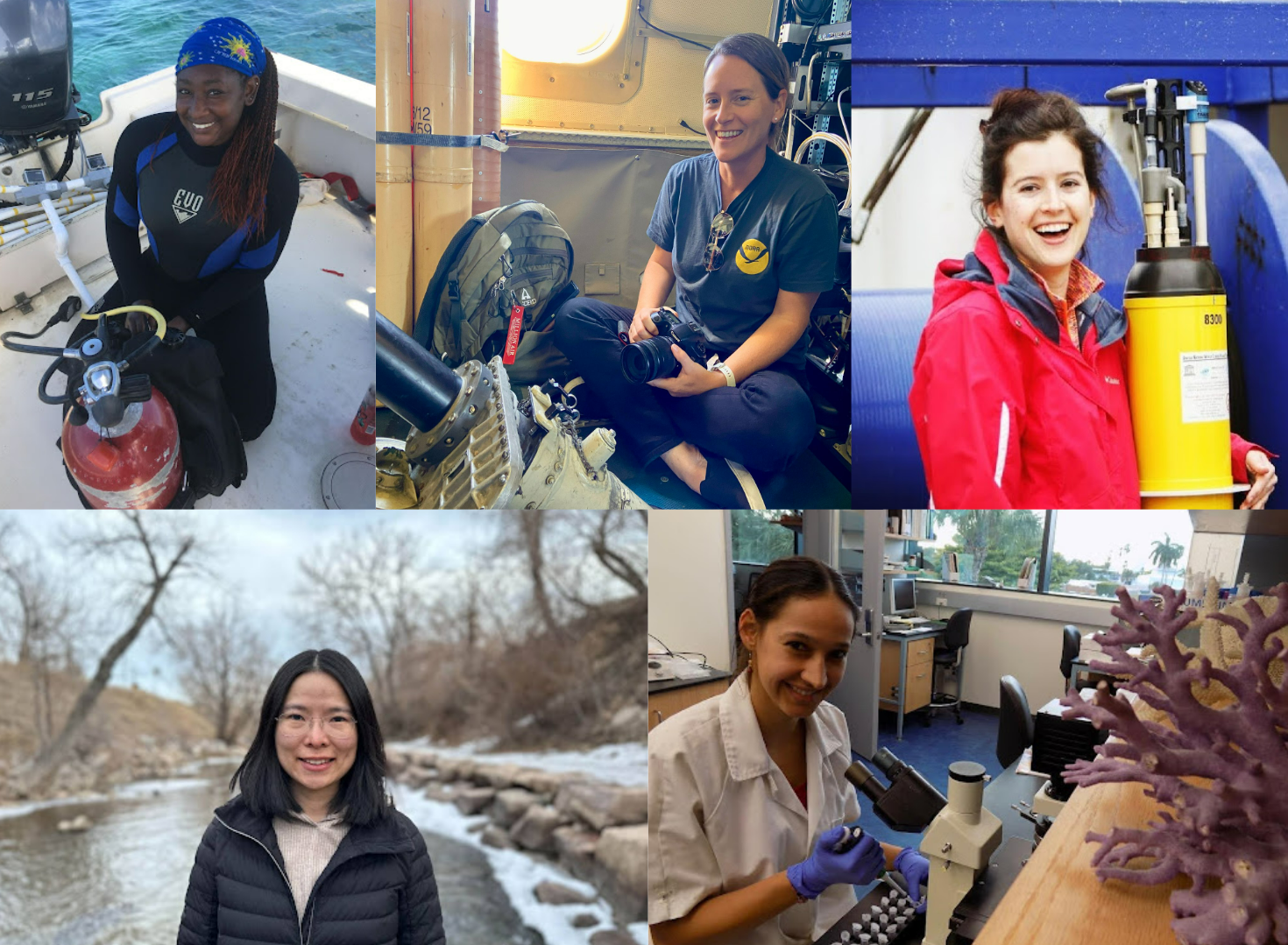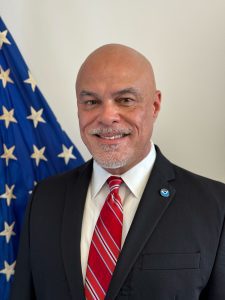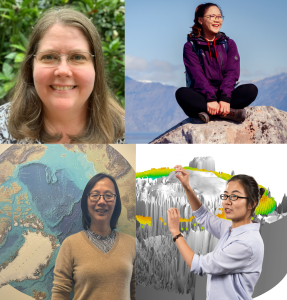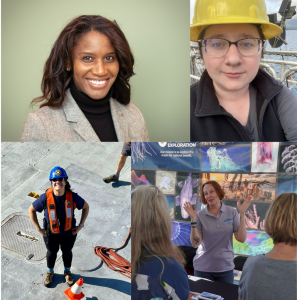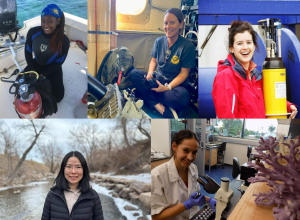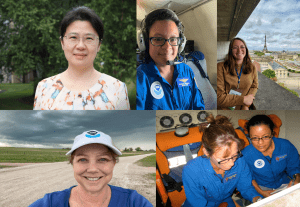March is Women’s History Month, and throughout the month we are recognizing the women of NOAA Research who contribute to the innovative and impactful progress towards NOAA’s mission. This week we are highlighting some of the women who are making critical contributions to NOAA’s work in marine heatwave research. The ocean absorbs 90% of the excess heat associated with global warming. As a result, we know that marine heatwaves all over the planet are becoming warmer over time with the added impact of climate change. In 2023, ocean temperatures around south Florida were the warmest on record for the month of July (dating back to 1981). Continue reading to meet five women who are advancing our knowledge of marine heatwaves, the impacts they have on marine ecosystems, and how we can better prepare for them in the future.

Natalie Freeman works as an oceanographer at NOAA’s Physical Sciences Laboratory in Boulder, Colorado. Much of Natalie’s current research is focused on the California Current System off the west coast of the United States, which is home to a very active marine ecosystem that is influenced by both natural and human-caused climate variability. Natalie and her colleagues are working to understand the location and timing of marine heatwaves and other extreme events like hypoxia (when low levels of oxygen in water can impact marine species’ behavior, metabolism, and survival) in this region. Their findings will inform marine resource management strategies.
Read Natalie’s inspiring story on how she entered this field and how mentoring the next generation of scientists empowers her by clicking here.
Natalie’s pathway to oceanographic research and NOAA is an inspiring one of breaking through barriers; she says the single moment of her career that she takes the most pride in is when she, “as a first-generation, female student from a single-parent, low-income household,” defended her doctoral dissertation in front of her mother, brothers, and mentors to become the very first Ph.D. graduate in her family.
Mentoring the next generation of scientists, women in particular, empowers Natalie in her day-to-day work. Her advice to these younger women is to “seek out and talk to multiple people that currently do what you dream of doing and ask them questions about their day-to-day work life and what path they took to become scientists.” While this may involve emailing someone you’ve never met, Natalie points out “the worst thing that could happen is that they don’t respond!”


At NOAA’s Atlantic Oceanographic & Meteorological Laboratory (AOML) in Miami, Florida, oceanographer Kayelyn Simmons uses tools like habitat photogrammetry and 3D mapping to understand the effects of warming ocean temperatures on coral reefs. By improving our understanding of both the negative impacts of hurricanes and coral bleaching and the positive impacts of coral restoration efforts, Kayelyn says NOAA can implement ecosystem-based management practices for coral reefs in the United States.
Read about Kayelyn’s passion for science communication, and her advice for women looking to enter this field by clicking here.
Kayelyn is passionate about science communication and outreach, and uses social media, mentorship, and education efforts to inspire young women to engage in STEM fields. She says that being transparent with her research accomplishments while engaging in these activities has had a huge impact on her success as a female scientist while inspiring others. Kayelyn says “sharing my research on social media has been very uplifting as it reaches a diverse, broader audience outside of NOAA,” and has allowed her to connect to the communities who are being impacted by climate change. Kayelyn’s outreach efforts were recognized in 2023, when she was awarded the OAR Team Members of the Year Award for Outreach and Education as part of AOML’s Coral Lab.
To the next generation of women looking to enter the field, Kayelyn says “know there will be challenges, but also know that there will be those that ‘see you.’ Stay true to your passion and naturally, like-minded individuals will want to uplift you and help you be successful in your career.” While Kayelyn says her own career path has had challenges, “especially with being a double minority, Black woman in science”, she is hopeful that leadership will continue to diversify and that collaborations between women will be encouraged and recognized at a higher level.


Meet Tongtong Xu, a research scientist with the Cooperative Institute for Research in Environmental Sciences (CIRES) at the University of Colorado Boulder and NOAA’s Physical Sciences Laboratory. Her work characterizes the seasonality of marine heatwaves in the northeastern Pacific Ocean and explores potential drivers that influence their seasonal development and duration. Tongtong’s research improves our capacity to forecast marine heatwaves, supports fisheries management, and aligns with NOAA’s mission of building a climate-ready nation.
Read about Tongtong’s path to receiving her Ph.D., how she thinks women can make a difference in her field, and more by clicking here.
Pursuing a Ph.D. is never easy, but Tongtong faced the added challenge of having to change research projects midway through. “Instead of giving up,” she says, “I took initiative to explore a new field and topic of interest, which ultimately led me to where I am today.” Tongtong reflects on the day she received her Ph.D. as one of the proudest moments in her career!
When it comes to ways women can make a difference in her field, Tongtong highlights the importance of improving visibility and representation. She says that “being a woman, a minority and an early career scientist working in this field helps improve the gender balance and diversity within the scientific community.” Tongtong says that by enhancing visibility, we can provide an example for students from similar backgrounds of “what is possible in the field” and inspire them to pursue careers in science.
Tongtong says she maintains a positive mindset while working in a climate-focused field by viewing challenges as “opportunities for positive change.” She believes that adopting an optimistic, “glass half-full” perspective helps foster a proactive approach in addressing climate, ocean, and atmosphere-related issues.


In her role as an assistant scientist at the Cooperative Institute for Marine and Atmospheric Studies (CIMAS) at NOAA’s Atlantic Oceanographic & Meteorological Laboratory in Miami, Florida, Ana Palacio-Castro is working to fill critical gaps in our understanding of the interplay between different climate stressors and South Florida’s ecosystems. These climate stressors, like ocean warming and acidification, marine heat waves, hypoxia, and harmful algal blooms, are likely to evolve under future climate change scenarios. Ana hopes that through her work, “we can develop more effective conservation and management strategies that enhance climate resilience.”
Read about Ana’s hopes for the future of marine heatwave research by clicking here.
Ana is committed to understanding the impacts of climate change on coral reef systems, which provide a range of ecosystem services from protecting coastlines from storms and erosion, to recreation opportunities, to sources of food and new medicines. Recent coral bleaching events across multiple regions, like the Caribbean and the eastern tropical Pacific, “have underscored the urgent need for action” Ana says. She hopes we can harness the momentum of these devastating bleaching events to drive meaningful change and inspire conservation efforts that are “underpinned by science-driven decision making and inclusive, gender-responsive policies.”
Looking ahead, Ana is hopeful that we continue our commitment to climate action and conservation, and she identifies collaborative approaches as a key element in supporting that vision. “By fostering dialogue and collaboration,” Ana says, “we can accelerate and upscale the implementation of effective solutions.” Ana also believes that women play a critical role in working towards such solutions, because women “are not only disproportionately affected by climate change but also [are] often at the forefront of environmental advocacy.”
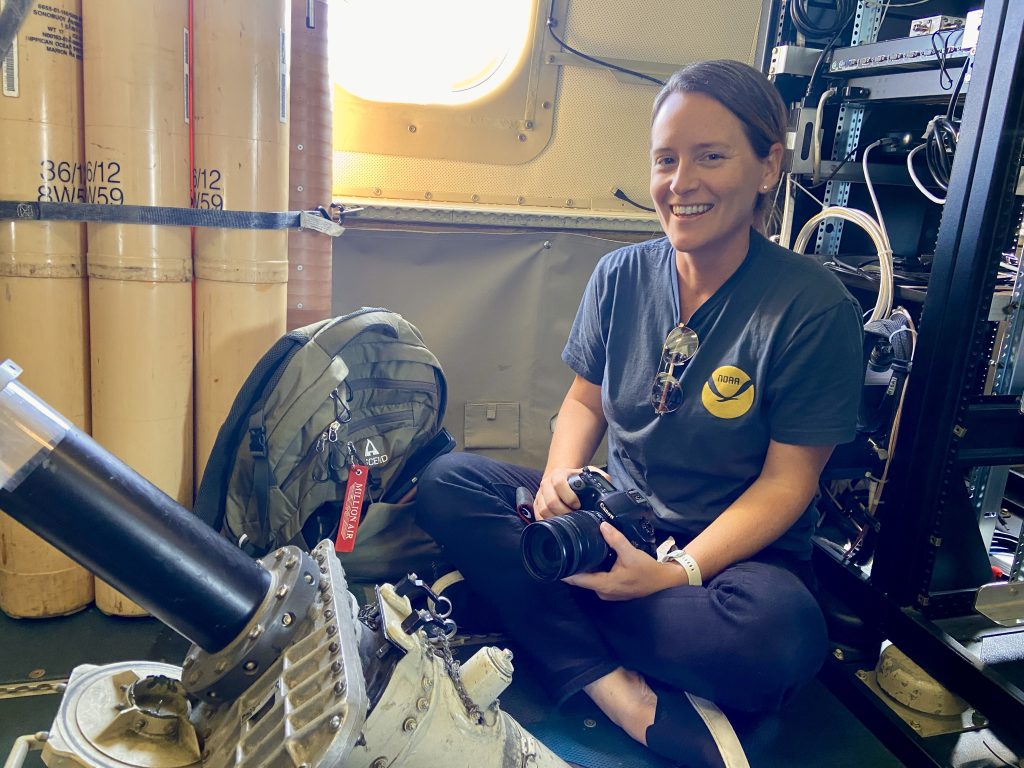

Laura Chaibongsai is the Communications Team Lead for NOAA’s Atlantic Oceanographic & Meteorological Laboratory (AOML). Laura is passionate about creating hands-on experiences for students and members of the community. She has taken kids shark tagging, led a community science marine debris study, and took Girl Scouts and reporters out to see bleached coral reefs firsthand. Laura’s proudest career moments are when she sees participants’ eyes light up when they do or see something new, knowing she has made an impact on their perception of the environment.
Learn how Laura stays positive while communicating challenging topics such as marine heatwaves, and what advice she has for women looking to enter her field by clicking here.
During the 2023 marine heatwave in Florida, Laura with the communications team and scientists at AOML worked tirelessly to monitor the coral bleaching and share updates with the public. She says it was challenging to stay positive at that time, but knowing that so many people were working on solutions gave her hope. Laura says that at NOAA, she is surrounded by people determined to make a positive difference, and that it inspires her to do the same. “From going into the field to gather critical data (even if that means flying through a hurricane or sailing through rough seas) to developing creative new ways of explaining our research, I see my colleagues doing everything in their power to protect lives and property.”
For young women looking to enter the field, Laura’s advice is to not be afraid to fail because “you never know where it will lead, what you might learn from the failure, or how it might help.” She says to try new things, build new skills, and that internships are an excellent way to find out what you like, “but also what you don’t like!”
